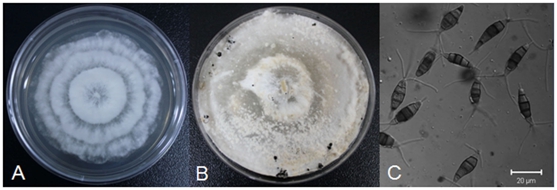Name:ZHONG Caihong
Tell:
Email:zhongch@wbgcas.cn
Organization:http://apsjournals.apsnet.org/doi/full/10.1094/PDIS-04-16-0488-PDN
New Study Reveals Diaporthe lithocarpus and Pestalotiopsis microspora Causing Postharvest Rot of Kiwifruit in China
2016-11-24
Kiwifruit is a very important commercial crop in China, the most important producer of the fruit worldwide. The relatively rapid expansion given over to kiwifruit has resulted in the spread of various diseases including postharvest rot.
During the cold storage period, initial infected symptoms begin as slightly shriveled areas on the fruit peel. Whenthe infected fruits have been removed and placed at room temperature, the internal tissue becomes disorganized, softer and lighter green in 6 to 10 days, and finally the severely decayed tissue emits a sour smell.
Since 2014, Prof. ZHONG Caihong and her research team from Wuhan Botanical Garden have been focusing on the research of kiwifruit postharvest rot. In order to clarify the pathogens causing kiwifruit rot disease in China,several strains were isolated from rotten fruits (‘Jinyan’, ‘Hongyang’, ‘Jinkui’, ‘Guichang’ and ‘Qinmei’ cultivars) collected from Henan, Hubei, Chongqing, Jiangxi, Guizhou, Shanxi, Sichuan, Fujian, Anhui and Hunan provinces during 2014-2015.
By using biological characteristics analysis, pathogenicity test and internal transcribed spacer (ITS) molecular sequencing, the research results showed that four species were responsible for kiwifruit rot disease in different regions of China. They were Phomopsis sp. (Diaporthsp.), Botryosphaeria dothidea, Alternaria alternate and Pestalotiopsis sp. The species of pathogen detected in different regions were significantly distinct. Among them, D. lithocarpus and P. microspor was firstly reported as the pathogen causing kiwifruit postharvest rot in China.
This was the first study that systematicanalyzed the pathogens of kiwifruit postharvest rot in China. The results revealed the distribution of pathogens in China, and laid a foundation for resistance mechanism research, disease resistance breeding and prevention of kiwifruit rot disease. Considering the economic importance of kiwifruit in China and throughout the world, further study of kiwifruit rot is warranted.
Results havebeen published in Plant Disease entitled “First Report ofDiaporthe lithocarpusCausing Postharvest Rot of Kiwifruit in Sichuan Province, China ” and “ First Report ofPestalotiopsis microsporaCausing Postharvest Rot of Kiwifruit in Hubei Province, China”.
This project was supported by the Chinese Academy of Sciences Science and Technology Service Network Program and the Ministry of Agriculture's Crop Germplasm Resource Conservation and Utilization Project.

Rot symptoms on infected kiwifruit and Colony characteristics, conidia of D. lithocarpus (Image by ZHONG’s group)

Colony characteristics, conidia of P. microspora (Image by ZHONG’s group)